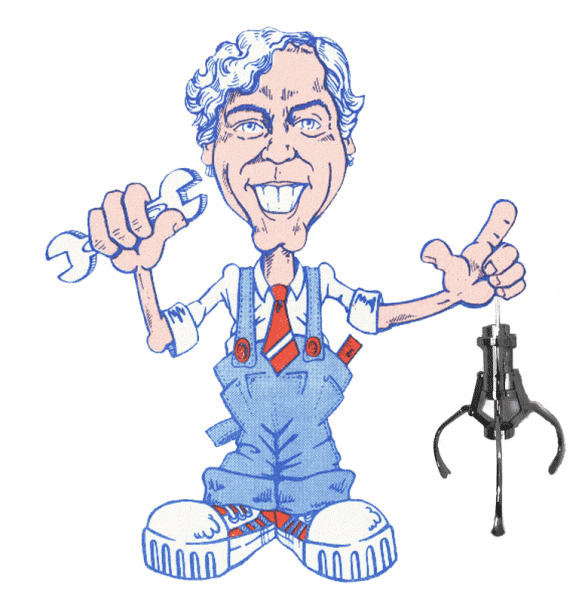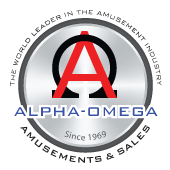

Here’s the Ticket!
T-Taps and Spade Connectors are Often the Source of Problems
(Dave Forlano, Alpha-Omega Amusements Regional Technician/Manager)
T-taps and spade connectors have become a quick substitute for splicing, soldering, and covering with electrical tape. However, the old method is still more reliable. Just today I have repaired 2 games that failed because of poor t-tap connections. In both cases, a motor had a t-tap and spade connector in use as a splice to the power source. A row reset motor on Down the Clown wasn’t working at all and a Hoop Fever ball gate was acting like a limit switch had gone bad. I removed the hardware and properly soldered the wire(s) to the motor connector(s). Game manufacturers should not be using this hardware in situations where motors and high vibrations are involved.
Knock Out Punch Belt Tightening Modification – ICE (Johnny Pokrajac, Quality Control Manager, Alpha-Omega Amusements)
It is a frequent problem for the large belt to come loose and cause this game to be out of order. Just tightening does not stop the belt from loosening. The ‘figure heads’ attached to the belt often hit the side of the cabinet as the belt starts to loosen and then it just gets worse. To solve the problem permanently I designed and installed a ‘Belt Tension-er’ that I located under the middle of the conveyor as shown in the pictures below. The Belt Tension-er keeps the belt tight as it rolls over the rollers. The Tension-er can be adjusted up or down as required using the slots that are cut into the top sections of each of the two plexi-glass sides.
Parts Cost: $15.00
Time to Complete Modification’s & Installation: 1 Hour
Parts Required: 2 pieces 11″ x 5″ Plexi and one 2″ Diameter -14″ Length PVC Tube. Nuts, Bolts as shown.
Tools Required: Drill and 2” D hole cutter and corresponding wrench for nuts & Bolts used.

Two Tips to Keep Games Operating (Larry Soffield, Alpha-Omega Amusements Tech)
I always keep a can of canned air with me to blow away ticket dust from ticket dispenser sensors and remove dust from all moving parts. I also keep a tube of grease handy and use it each time I come across a moving part in a game I am working on. I try to impress on each location that there needs to be a charted monthly schedule listing when all moving parts on each specific game need to be greased or oiled and dated and signed when completed. This really cuts down on service calls.
Cyclone Rim Lights Very Dim. (Ramon Vivar, Master Tech, Alpha-Omega Amusements)
Cyclone is still a workhorse game and keeping the running rim lights bright is important. A client called reporting that all of the rim lights on his Cyclone were very dim. I asked him to send me the main circuit board. When received, I tested it in a Cyclone we had in the shop. The rim lights were indeed very dim. The voltage feeding the six ring light boards was measured at only 6 volts instead of the required 12 volts. I replaced the usual board components along that line, namely bridge rectifier DB3 and the two regulators VR3 and VR4, which are both LM338K. After replacing those, the ring lights came on very bright. I smiled at another easy repair and shipped the main board back with a very reasonably priced invoice.
The client received the repaired board, plugged it into his Cyclone and had the same problem. He called me immediately. What else could be causing this problem? I asked him to send me back the main circuit board together with all 6 ring light boards. When received, I swapped his main board and all 6 of his ring light boards into my Cyclone and to my surprise, all the ring lights were shining bright. How can this be happening?
The only other logical possibility was that a problem existed in his Cyclone game itself. Final step, the client unhappily brought the whole game to our shop. With all original boards in his Cyclone, we both see the problem–ring lights are dim. ..So, I removed his main board and tried it again in my Cyclone and it worked perfectly—ring lights are bright. But when I installed my Cyclone board into his Cyclone game, all of the ring lights were bright. The client smiled and asked if he could keep my Cyclone board, but I needed to know what I missed.
To recap. His board would work in my Cyclone but not in his Cyclone and my board would work in both Cyclones. I checked thoroughly for any wiring anomalies but couldn’t find anything. I concluded that some “imperfection” in his board plus his machine’s own “imperfections” caused them not to work together, but I wanted to ‘solve’ the problem because I knew that I would get stuck with his board and have to repair it somehow
.
Upon close inspection of his circuit board, the difference I finally noticed was the LM338K regulators that I used to replace VR3 and VR4 had a different brand name from the rest of the regulators on both boards. All the original regulators are made by SGS Thomson while the ones I used as replacements are made by Texas Instruments. I considered it initially as a long shot, because brands doesn’t really matter as long as they are the same device, plus considering they are both name brands. I proceeded replacing VR3 and VR4 with SGS Thomson regulators and to my surprise, it worked!!. So brands can make a difference. Now I’m thinking how many unsolved board troubleshooting issues did I gave up on in the past due to not realizing this? I will keep the below picture on the shop wall to always remind me of what I learned after 40 years on the job.
 To the right is a picture of both LM338K regulators. The one at the bottom is the original SGS Thomson used in Cyclone and the one at the top is made by Texas Instruments. They should be identical, but, well, not exactly. I will keep the picture on the shop wall to always remind me of what I learned after 40 years on the job.
To the right is a picture of both LM338K regulators. The one at the bottom is the original SGS Thomson used in Cyclone and the one at the top is made by Texas Instruments. They should be identical, but, well, not exactly. I will keep the picture on the shop wall to always remind me of what I learned after 40 years on the job.




